2010 年上海华东政法大学博士入学考试英语真题
Part I: Grammar & Vocabulary (10%)
Directions: Choose the word or phrase that best completes each sentence and then mark your
answers on your ANSWER SHEET 1.
1. To most people, marriage is a_______ affair.
A. love-and-hatred
C. win-win situation
B. now or never
D. give-and-take
2. We tried to settle the argument but ________ nothing.
A. finish
B. completed
C. ended
D. accomplished
3. We should settle our difference by ______________ not by war.
A. assignment
B. compromise C. security
D. appointment
4. Tramps as pioneers? It seemed absurd. I kept _____ the idea _____.
A. pondering, about B. mulling, about
C. thinking, of D. speculating, on
5. People become _____ the place they live in.
A. associated with
B. attached to
C. appreciative of
D. attachable with
6. Since the days of Columbus, America has been another name for opportunity,
where one seems to accomplish _______.
A. anything
B. something
C. nothing
D. little
7. No matter how difficult the problem is, he can handle it _____.
A. at equal ease
B. of equal ease
C. with equal ease D. from equal ease
8. The successful tramps would be ______ the pioneers.
A. equal
B. equal of
C. equal to
D. equals
It’s likely for the outstanding ones to stand out ______ the rest.
9.
A. off
B.
10. It’s human nature to _____ wealth ____ reach and neglect happiness already
D. above
C. from
B. of
______.
A. crave, within, within reach
B. crave for, out of, in hand
C. chase after, beyond, beyond reach
D. seek after, within, out of hand
11. ___ her surprise, migrant workers are __________.
A. Out of, a tough and hard-working lot
�
B. To, a diligent and cheerful lot
C. To, diligent and tough lots.
D. Out of, tough and hard-working lot
12. When asked whether it’s the ______ he is _____, the answer, after some ____, is
invariably the same.
A. money, after, hesitant
B. money, craving for, thought
C. money, chasing after, considerate
D. money, craving, thinking
13. Resourceful as the general was, he let ____ spread that he would attack on a
certain day next month.
A. the word
B. word
C. a word
D. words
14. The ______ would perish in a world of fierce competition.
A. adaptable
C. inadaptable
B. adapted
D. adaptive
15. It’s easy for the tramps to ______ temper and get _____ with the steady job.
A. lose, sick
B. control, fed up
C. lose, fed up
D. control, sick and tired
16. We genuinely ______ your opinion and your suggestion.
A. appreciate of
C. evaluate as
B. value
D. estimate about
17. The Empire State Building is a famous______ on the New York skyline.
A. stumbling block
B. stepping block
C.
D. spring board
landmark
18. The teacher tried to _____ the new boy ____ by letting him say something about
his hometown.
A. draw…for
B. draw…back
C. draw… away
D. draw… upon
19. The grass was ____ with dew. Drops of water _______ in the sun.
A. full, sparkled
B. wet, sparkled
C. filled, gleamed
D. abundant, gleamed
20. What he said last night is ______ a nuisance than it should be.
A. more of
B. less than
C. just as
D. more like
Part II: Reading Comprehension (15%).
�
Direction: There are 3 reading passages in this part. Each passage is followed by
some questions or unfinished statements. For each of them there are four choices
marked A, B, C, and D. You should decide on the best choice and mark the
corresponding letter on the Answer Sheet 1 with a single line through the center.
Passage One:
Questions 21 to 25 are based on the following passage.
Between the eighth and eleventh centuries A.D.,
the Byzantine Empire staged an almost
unparalleled economic and cultural revival, a recovery that is all the more striking because it
followed a long period of severe internal decline. By the early eighth century, the empire had lost
roughly two-thirds of the territory it had possessed in the year 600, and its remaining area was
being raided by Arabs and Bulgarians, who at times threatened to take Constantinople and
extinguish the empire altogether. The wealth of the state and its subjects was greatly diminished,
and artistic and literary production had virtually ceased. By the early eleventh century, however,
the empire had regained almost half of its lost possessions, its new frontiers were secure, and its
influence extended far beyond its borders. The economy had recovered, the treasury was full, and
art and scholarship had advanced.
To consider the Byzantine military, cultural, and economic advances as differentiated aspects of a
single phenomenon is reasonable. After all, these three forms of progress have gone together in a
number of states and civilizations. Rome under Augustus and fifth-century Athens provide the
most obvious examples in antiquity. Moreover, an examination of the apparent sequential
connections among military, economic, and cultural forms of progress might help explain the
dynamics of historical change.
The common explanation of these apparent connections in the case of Byzantium would run like
this: when the empire had turned back enemy raids on its own territory and had begun to raid and
conquer enemy territory, Byzantine resources naturally expanded and more money became
available to patronize art and literature. Therefore, Byzantine military achievements led to
economic advances, which in turn led to cultural revival.
No doubt this hypothetical pattern did apply at times during the course of the recovery. Yet it is not
clear that military advances invariably came first. Economic advances second, and intellectual
advances third. In the 860’s the Byzantine Empire began to recover from Arab incursions so that
by 872 the military balance with the Abbasid Caliphate had been permanently altered in the
empire’s favor. The beginning of the empire’s economic revival, however, can be placed between
810 and 830. Finally, the Byzantine revival of learning appears to have begun even earlier. A
number of notable scholars and writers appeared by 788 and, by the last decade of the eighth
century, a cultural revival was in full bloom, a revival that lasted until the fall of Constantinople in
1453.Thus the commonly expected order of military revival followed by economic and then by
�
cultural recovery was reversed in Byzantium. In fact, the revival of Byzantine learning may itself
have influenced the subsequent economic and military expansion.
21. Which of the following best states the central idea of the passage?
(A) The Byzantine Empire was a unique case in which the usual order of military and economic
revival preceding cultural revival was reversed.
(B) After 810 Byzantine economic recovery spurred a military and, later, cultural expansion that
lasted until 1453.
(C) The eighth-century revival of Byzantine learning is an inexplicable phenomenon, and its
economic and military precursors have yet to be discovered.
(D) The revival of the Byzantine Empire between the eighth and eleventh centuries shows cultural
rebirth preceding economic and military revival, the reverse of the commonly accepted order
of progress.
22. The primary purpose of the second paragraph is which of the following?
(A) To establish the uniqueness of the Byzantine revival
(B) To show that Augustan Rome and fifth-century Athens are examples of cultural, economic,
and military expansion against which all subsequent cases must be measured
(C) To suggest
that cultural, economic, and military advances have tended to be closely
interrelated in different societies.
(D) To argue that, while the revivals of Augustan Rome and fifth-century Athens were similar,
they are unrelated to other historical examples
23. It can be inferred from the passage that by the eleventh century the Byzantine military forces
(A) had reached their peak and begun to decline
(B) had eliminated the Bulgarian army
(C) were comparable in size to the army of Rome under Augustus
(D) were strong enough to withstand the Abbasid Caliphate’s military forces
24. In the third paragraph, the author most probably provides an explanation of the apparent
connections among economic, military, and cultural development in order to
(A) suggest that the process of revival in Byzantium accords with this model
(B) set up an order of events that is then shown to be not generally applicable to the case of
Byzantium
(C) cast aspersions on traditional historical scholarship about Byzantium
(D) suggest that Byzantium represents a case for which no historical precedent exists
25. Which of the following does the author mention as crucial evidence concerning the manner in
which the Byzantine revival began?
(A) The Byzantine military revival of the 860’s led to economic and cultural advances.
(B) The Byzantine cultural revival lasted until 1453.
(C) The Byzantine economic recovery began in the 900’s.
(D) The revival of Byzantine learning began toward the end of the eighth century.
�
Passage Two
Questions 26 to 30 are based on the following passage.
In 1896 a Georgia couple suing for damages in the accidental death of their two year old was told
that since the child had made no real economic contribution to the family, there was no liability for
damages. In contrast, less than a century later, in 1979, the parents of a three year old sued in New
York for accidental-death damages and won an award of $750,000.
The transformation in social values implicit in juxtaposing these two incidents is the subject of
Viviana Zelizer’s excellent book, Pricing the Priceless Child. During the nineteenth century, she
argues, the concept of the “useful” child who contributed to the family economy gave way
gradually to the present-day notion of the “useless” child who, though producing no income for,
and indeed extremely costly to, its parents, is yet considered emotionally “priceless.” Well
established among segments of the middle and upper classes by the mid-1800’s, this new view of
childhood spread throughout society in the late-nineteenth and early-twentieth centuries as
reformers introduced child-labor regulations and compulsory education laws predicated in part on
the assumption that a child’s emotional value made child labor taboo.
For Zelizer the origins of this transformation were many and complex. The gradual erosion of
children’s productive value in a maturing industrial economy, the decline in birth and death rates,
especially in child mortality, and the development of the companionate family (a family in which
members were united by explicit bonds of love rather than duty) were all factors critical in
changing the assessment of children’s worth. Yet “expulsion of children from the ‘cash nexus,’
although clearly shaped by profound changes in the economic, occupational, and family
structures,” Zelizer maintains. “was also part of a cultural process ‘of sacralization’ of children’s
lives.” Protecting children from the crass business world became enormously important for
late-nineteenth-century middle-class Americans, she suggests; this sacralization was a way of
resisting what they perceived as the relentless corruption of human values by the marketplace.
In stressing the cultural determinants of a child’s worth, Zelizer takes issue with practitioners of
the new “sociological economics,” who have analyzed such traditionally sociological topics as
crime, marriage, education, and health solely in terms of their economic determinants. Allowing
only a small role for cultural forces in the form of individual “preferences,” these sociologists tend
to view all human behavior as directed primarily by the principle of maximizing economic gain.
Zelizer is highly critical of this approach, and emphasizes instead the opposite phenomenon: the
power of social values to transform price. As children became more valuable in emotional terms,
she argues, their “exchange” or “surrender” value on the market, that is, the conversion of their
intangible worth into cash terms, became much greater.
26. It can be inferred from the passage that accidental-death damage awards in America during the
nineteenth century tended to be based principally on the
�
(A) earnings of the person at time of death
(B) wealth of the party causing the death
(C) degree of culpability of the party causing the death
(D) amount of money that had been spent on the person killed
27. It can be inferred from the passage that in the early 1800’s children were generally regarded by
their families as individuals who
(A) needed enormous amounts of security and affection
(B) required constant supervision while working
(C) were important to the economic well-being of a family
(D) were unsuited to spending long hours in school
28. The primary purpose of the passage is to
(A) review the literature in a new academic subfield
(B) present the central thesis of a recent book
(C) contrast two approaches to analyzing historical change
(D) refute a traditional explanation of a social phenomenon
29. It can be inferred from the passage that which of the following statements was true of
American families over the course of the nineteenth century?
(A) The average size of families grew considerably
(B) The percentage of families involved in industrial work declined dramatically.
(C) Family members became more emotionally bonded to one another.
(D) Family members spent an increasing amount of time working with each other.
30. Zelizer refers to all of the following as important influences in changing the assessment of
children’s worth EXCEPT changes in
(A) the mortality rate
(B) the nature of industry
(C) the nature of the family
(D) attitudes toward reform movements
Questions 31 to 35 are based on the following passage.
In the two decades between 1910 and 1930, over ten percent to the Black population of the United
States left the South, where the preponderance of the Black population had been located, and
migrated to northern states, with the largest number moving, it is claimed, between 1916 and 1918.
It has been frequently assumed, but not proved, that the majority of the migrants in what has come
to be called the Great Migration came from rural areas and were motivated by two concurrent
factors: the collapse of the cotton industry following the boll weevil infestation, which began in
1898, and increased demand in the North for labor following the cessation of European
immigration caused by the outbreak of the First World War in 1914. This assumption has led to the
conclusion that the migrants’ subsequent lack of economic mobility in the North is tied to rural
�
background, a background that implies unfamiliarity with urban living and a lack of industrial
skills.
But the question of who actually left the South has never been rigorously investigated. Although
numerous investigations document an exodus from rural southern areas to southern cities prior to
the Great Migration, no one has considered whether the same migrants then moved on to northern
cities. In 1910 over 600,000 Black workers, or ten percent of the Black work force, reported
themselves to be engaged in “manufacturing and mechanical pursuits,” the federal census category
roughly encompassing the entire industrial sector. The Great Migration could easily have been
made up entirely of this group and their families. It is perhaps surprising to argue that an
employed population could be enticed to move, but an explanation lies in the labor conditions then
prevalent in the South.
About thirty-five percent of the urban Black population in the South was engaged in skilled trades.
Some were from the old artisan class of slavery-blacksmiths, masons, carpenters-which had had a
monopoly of certain trades, but
they were gradually being pushed out by competition,
mechanization, and obsolescence. The remaining sixty-five percent, more recently urbanized,
worked in newly developed industries – tobacco, lumber, coal and iron manufacture, and railroads.
Wages in the South, however, were low, and Black workers were aware, through labor recruiters
and the Black press, that they could earn more even as unskilled workers in the North than they
could as artisans in the South. After the boll weevil infestation, urban Black workers faced
competition from the continuing influx of both Black and White rural workers, who were driven to
undercut the wages formerly paid for industrial jobs.
Thus, a move north would be seen as advantageous to a group that was already urbanized and
steadily employed, and the easy conclusion tying their subsequent economic problems in the
North to their rural background comes into question.
31. The author indicates explicitly that which of the following records has been a source of
information in her investigation?
(A) United States Immigration Service reports from 1914 to 1930
(B) Payrolls of southern manufacturing firms between 1910 and 1930
(C) The volume of cotton exports between 1898 and 1910
(D) The federal census of 1910
32. In the passage, the author anticipates which of the following as a possible objection to her
argument?
(A) It is uncertain how many people actually migrated during the Great Migration.
(B) The eventual economic status of the Great Migration migrants has not been adequately traced.
(C) It is not likely that people with steady jobs would have reason to move to another area of the
country.
(D) It is not true that the term “manufacturing and mechanical pursuits” actually encompasses the
entire industrial sector.
�
33. According to the passage, which of the following is true of wages in southern cities in 1910?
(A) They were being pushed lower as a result of increased competition.
(B) They had begun t to rise so that southern industry could attract rural workers.
(C) They had increased for skilled workers but decreased for unskilled workers.
(D) They had increased in large southern cities but decreased in small southern cities.
34. The author cites each of the following as possible influences in a Black worker's decision to
migrate north in the Great Migration EXCEPT
(A) wage levels in northern cities
(B) labor recruiters
(C) competition from rural workers
(D) voting rights in northern states
35. The primary purpose of the passage is to
(A) support an alternative to an accepted methodology
(B) present evidence that resolves a contradiction
(C) introduce a recently discovered source of information
(D) challenge a widely accepted explanation
Part III: Directions: Translate the following Chinese sentences into English on
ANSWER SHEET 2 (10%):
1. 分析人士对浮动的美元会走向何方看法不一。
2. 该研究中心估计那一年由于假冒商品导致税收损失数十亿元。
3. 校长的演讲生动风趣,听众时时报以震耳的掌声。
4. 应试教育将学生培养成了考试机器,剥夺了学生的想象力。
5. 这个地区农民的现金收入翻了一番,这得益于农作物的多种栽培。
Part IV: English Writing (15%)
DIRECTIONS: For this part, you are allowed 30 minutes to write a short essay to
respond to the following questions. You should write about 180 words and write your
essay on the ANSWER SHEET 2.
News editors decide what to broadcast on television and what to print in newspapers. What factors
do you think influence these decisions? Do we become used to bad news? Would it be better if
more good news was reported?
NOTES: Marks will be awarded for content, organization, grammar and
�
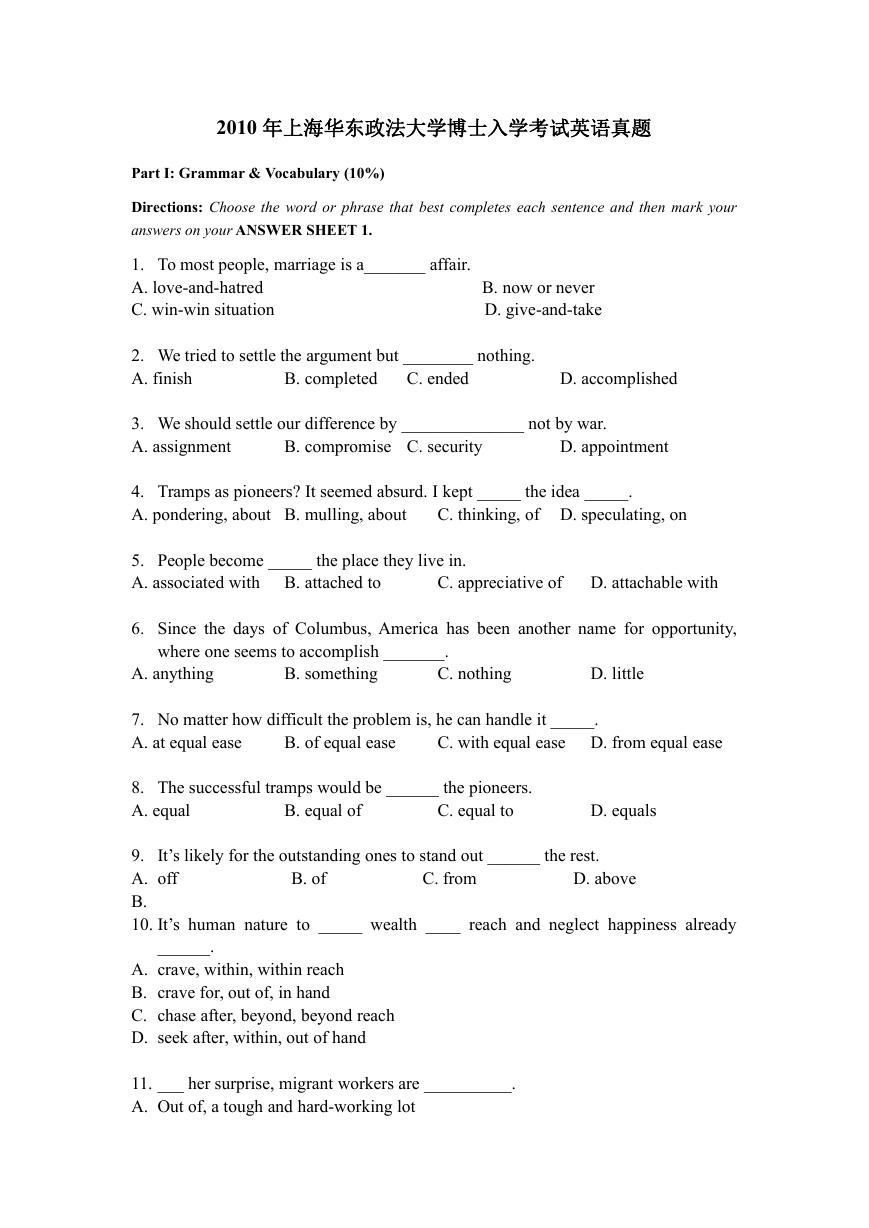

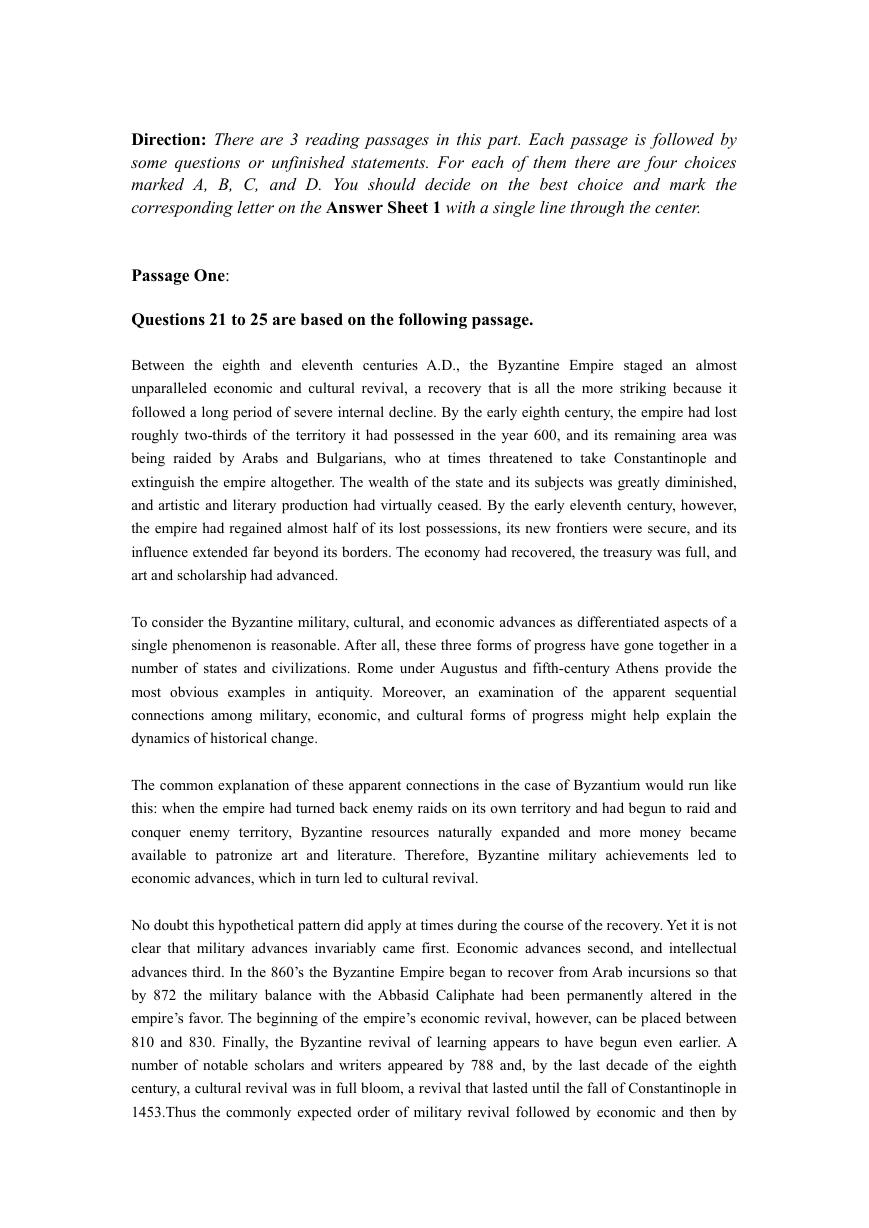
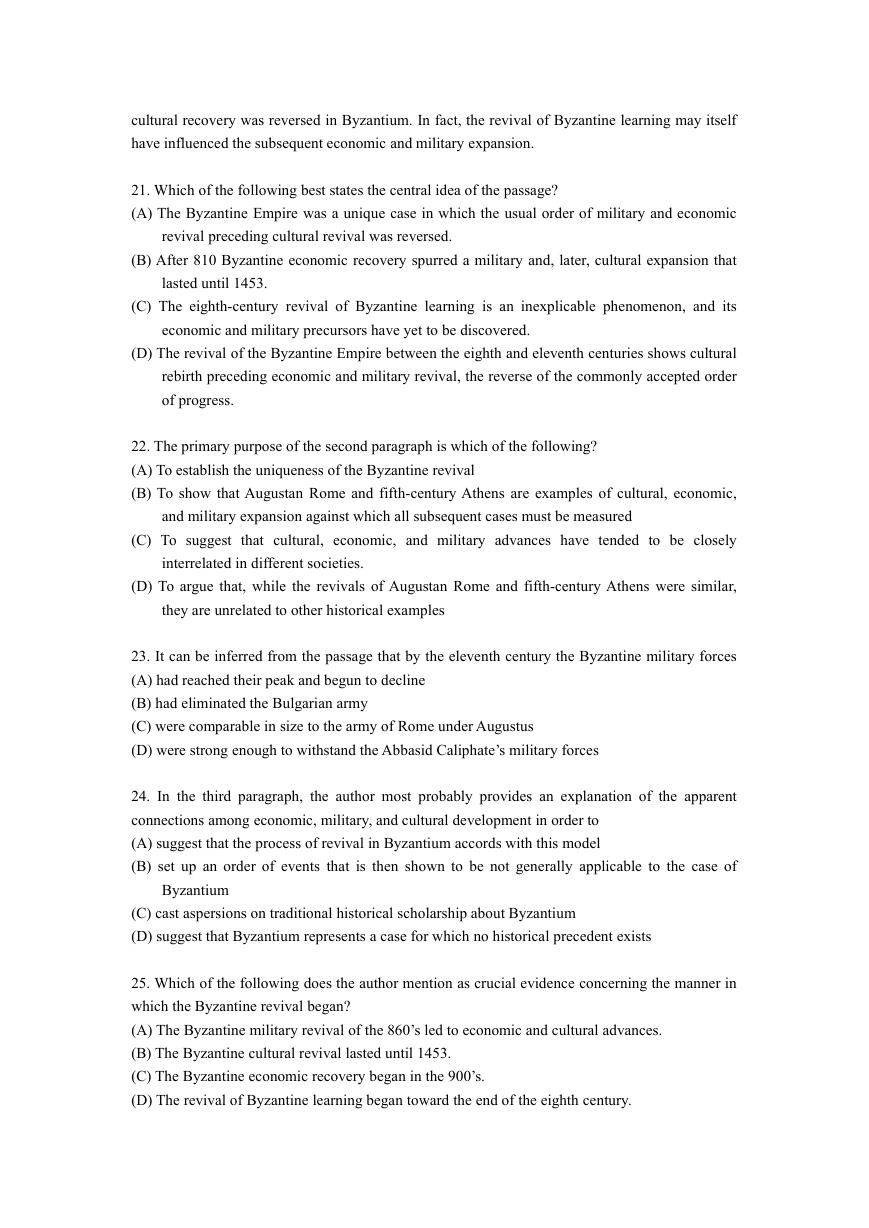
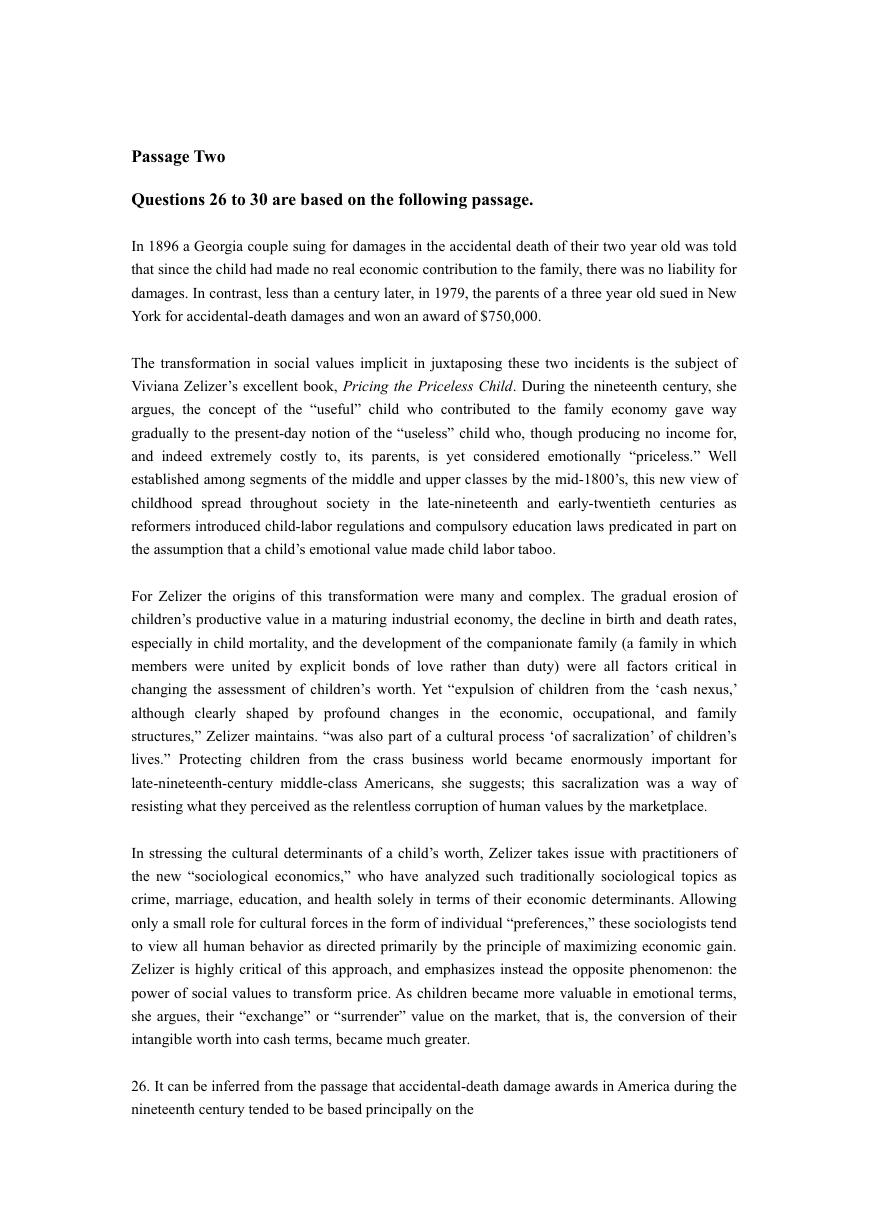
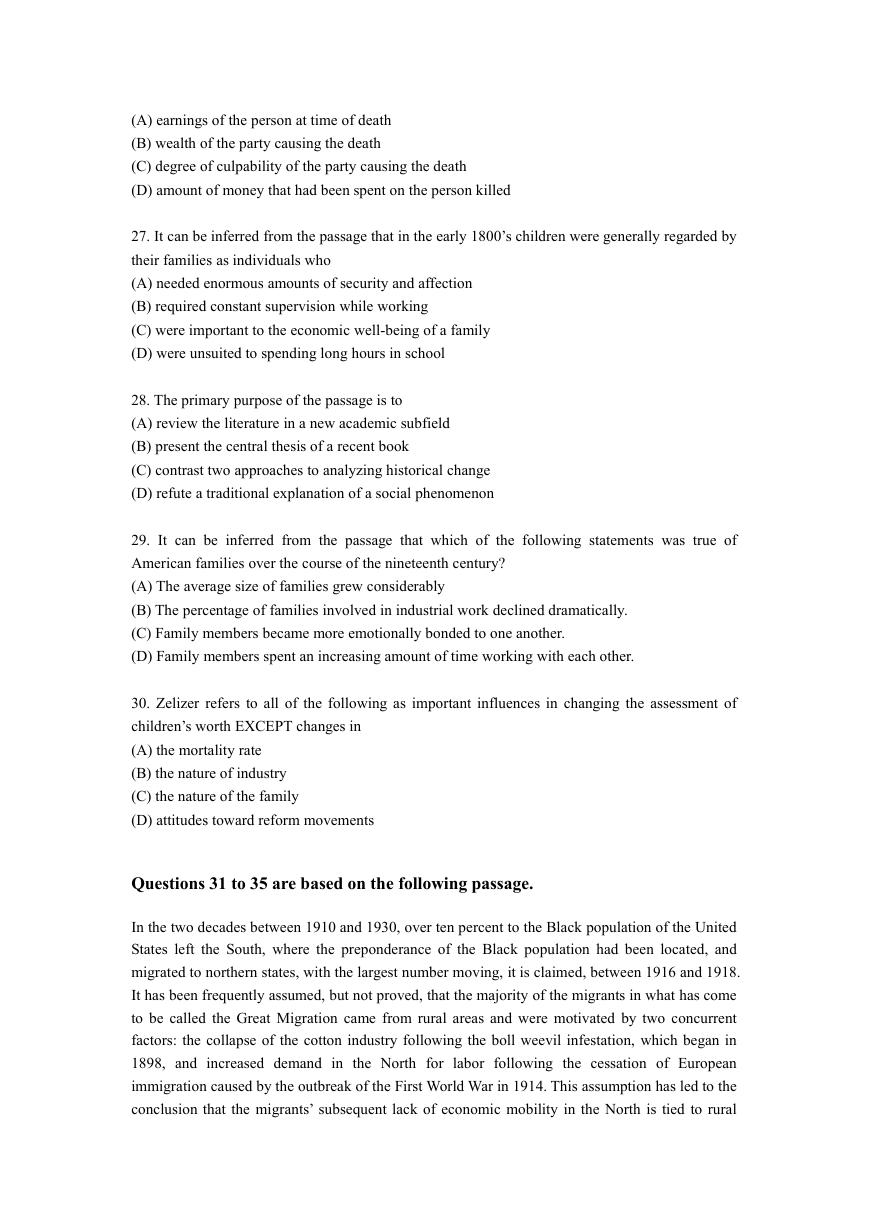
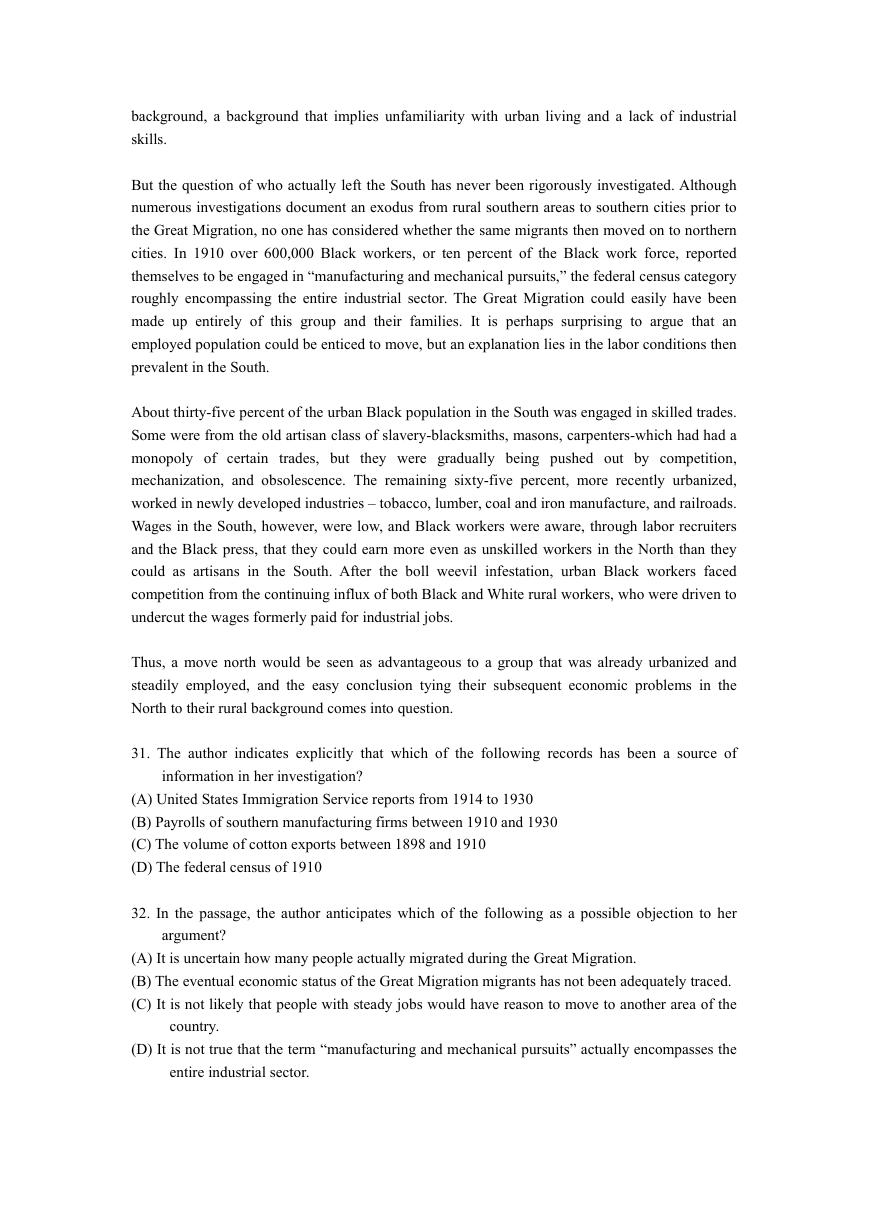
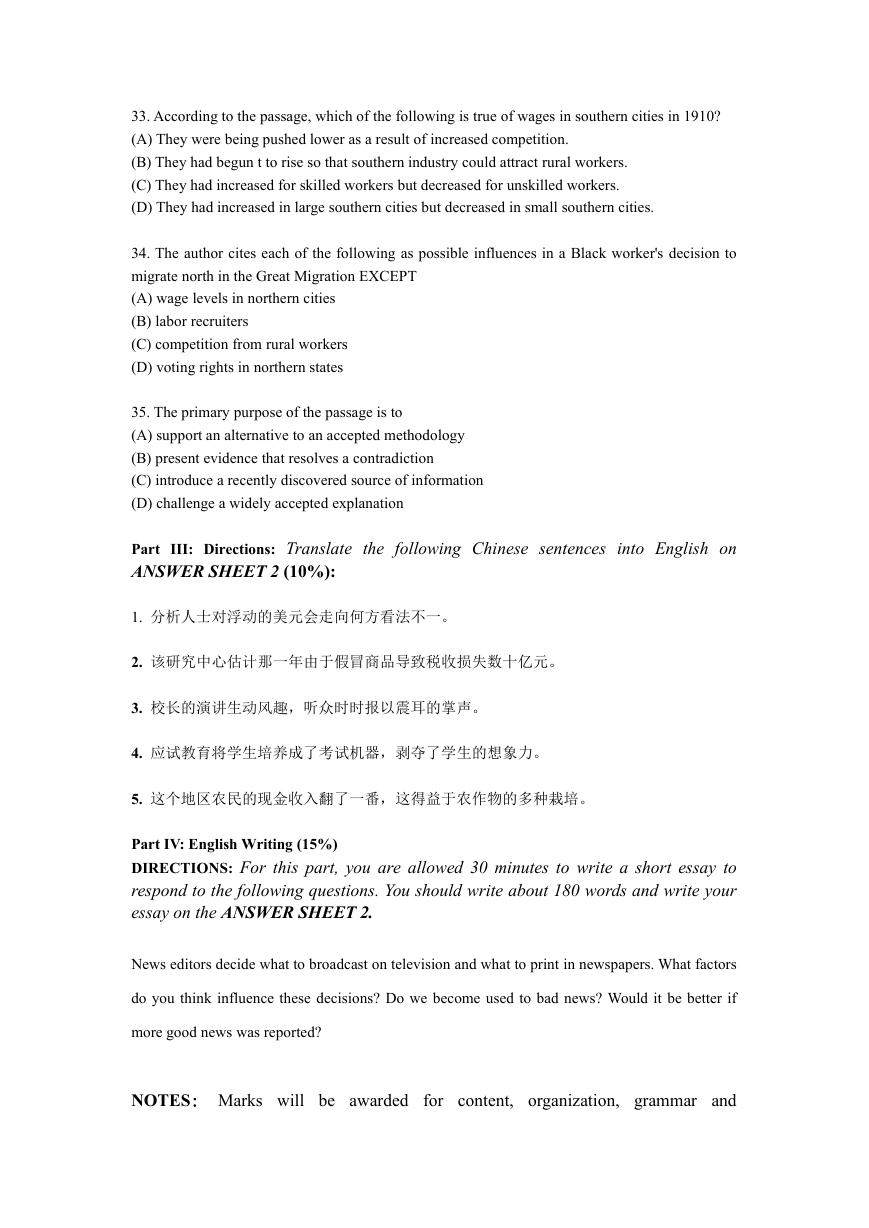








 2023年江西萍乡中考道德与法治真题及答案.doc
2023年江西萍乡中考道德与法治真题及答案.doc 2012年重庆南川中考生物真题及答案.doc
2012年重庆南川中考生物真题及答案.doc 2013年江西师范大学地理学综合及文艺理论基础考研真题.doc
2013年江西师范大学地理学综合及文艺理论基础考研真题.doc 2020年四川甘孜小升初语文真题及答案I卷.doc
2020年四川甘孜小升初语文真题及答案I卷.doc 2020年注册岩土工程师专业基础考试真题及答案.doc
2020年注册岩土工程师专业基础考试真题及答案.doc 2023-2024学年福建省厦门市九年级上学期数学月考试题及答案.doc
2023-2024学年福建省厦门市九年级上学期数学月考试题及答案.doc 2021-2022学年辽宁省沈阳市大东区九年级上学期语文期末试题及答案.doc
2021-2022学年辽宁省沈阳市大东区九年级上学期语文期末试题及答案.doc 2022-2023学年北京东城区初三第一学期物理期末试卷及答案.doc
2022-2023学年北京东城区初三第一学期物理期末试卷及答案.doc 2018上半年江西教师资格初中地理学科知识与教学能力真题及答案.doc
2018上半年江西教师资格初中地理学科知识与教学能力真题及答案.doc 2012年河北国家公务员申论考试真题及答案-省级.doc
2012年河北国家公务员申论考试真题及答案-省级.doc 2020-2021学年江苏省扬州市江都区邵樊片九年级上学期数学第一次质量检测试题及答案.doc
2020-2021学年江苏省扬州市江都区邵樊片九年级上学期数学第一次质量检测试题及答案.doc 2022下半年黑龙江教师资格证中学综合素质真题及答案.doc
2022下半年黑龙江教师资格证中学综合素质真题及答案.doc